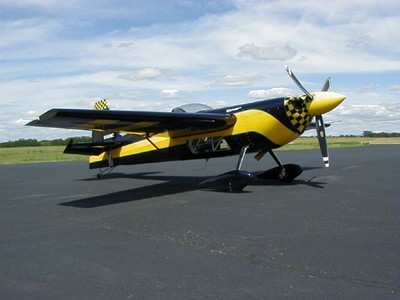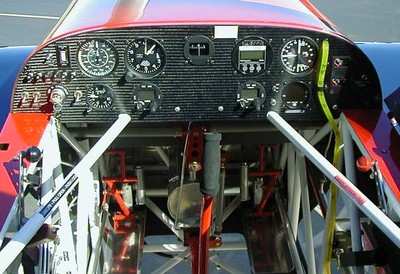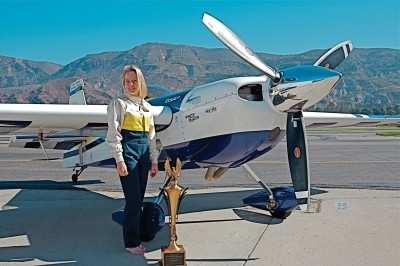Control Issues Doomed Recovery Options
The UK's AAIB has published a final report on the tragic
accident that claimed the life of IAC President and US Aerobatic
Team member, Vicki Cruse.
The 22 August 2009 accident occurred as part of the 2009
World Aerobatic Championships being flown over Silverstone Circuit,
Towcester, Northamptonshire. Vicki was flying a leased
Zivko Aeronautics Inc Edge 540, N540BW (standard practice for
foreign competition due to the complexities and expense of
transporting US Team aircraft overseas).

The AAIB summarized their findings by noting that, "The aircraft
was being flown in an aerobatic competition during which it failed
to recover from a downwards snap roll manoeuvre, initiated at about
2,300 ft agl. The aircraft continued to rotate until it struck the
ground, fatally injuring the pilot. The investigation discovered a
mechanism whereby rudder pedal extensions used by the pilot could
have contributed to a rudder control restriction, but pilot
incapacitation was also considered a possible contributory
factor."
More specific detail note that, "The accident occurred during
the fifth manoeuvre of the sequence, which was the last manoeuvre
the pilot had practised minutes beforehand. The manoeuvre called
for a pull up to the vertical, followed by half of an eight point
roll (rolling through 180°). The aircraft was then to be
‘pushed over’ the top of the manoeuvre until it was
pointing vertically nose down, before carrying out a positive snap
roll to the left through 1¼ turns and pulling out to the
horizontal. The aircraft appeared to perform the initial stages of
the manoeuvre normally but it did not recover from the downwards
1¼ snap roll. Instead, the aircraft continued to rotate in a
nose-low attitude until it struck the ground."
The AAIB also reports that, "...the aircraft had struck the
ground in a nose-down, left wing-low attitude with significant
rotation..."
AAIB noted that the control system was pretty much intact at
impact but spent considerable time looking at the rudder and rudder
pedal control assemblies, noting that Vicki had reported previously
that she had experienced a problem 'whilst carrying out a snap roll
during practice. During the manoeuvre her right foot had bent the
right foot plate downwards, deforming it. The footplate was
straightened after the flight. The team engineer prepared a pair of
longer, stiffer footplates but these had not been fitted at the
time of the accident.' Additionally, "According to information
posted by the pilot on her internet site, another pilot had also
bent the footplate, whilst getting into the aircraft, and had bent
it back."

Edge 540 -- File Photo
AAIB Investigators looked at a number of failure modes based on
these concerns as well as observations of video and witness reports
regarding the last few seconds of the flight... in which it became
clear that the proper corrective control inputs were either not
being applied or could not be applied. AAIB personnel used video of
the same maneuver performed by Vicki in that airplane during
practice against the fatal sequence that occurred a short time
later. The AAIB concluded that "...a rudder control restriction
could occur if the lower attachment of the rudder pedal extension
had moved outboard and the pedal in question, having been pushed
forward, was subsequently moved aft towards the neutral position.
The range of rudder positions in which a restriction could occur on
the left pedal assembly, with the extension fitted, was estimated
to be between 6° and 23° left rudder deflection. Similar
values were estimated for a restriction on the right rudder
assembly. It was concluded that, if such a restriction occurred, it
was unlikely that the force a pilot could apply on the pedal
extension would be sufficient to overcome the restriction. The way
to free the pedals would be to shift the lower extension attachment
point inboard."
The AAIB's analysis of the video evidence stated that
examination revealed "three anomalies at the expected point of
recovery; the inappropriate rudder position, the unusual aircraft
pitch attitude (compared to the practice case) and the
pilot’s head position, which would be expected to have been
central in the cockpit at that point.
As the manoeuvre continued, there were no apparent control inputs
made which could be regarded as being part of a positive recovery
attempt. Instead, the rudder remained displaced in the direction of
roll, driving the rotation. Although aileron deflection did return
to near zero for much of the latter part of the descent, it was at
times near full deflection in the early stages, again providing a
strong driving force for the rotation. There was almost no aileron
movement to oppose the rotation.
The rudder position is the most significant anomaly. Either the
pilot reacted correctly to the situation but was physically
prevented from removing the pro-rotation rudder, or her ability to
recognize and/or react to the situation had become impaired.

Edge 540 -- File Photo
The examination of the rudder pedal assemblies revealed that a
restriction could occur with this set of extensions fitted.
Moreover, such was the design of the extensions that they could
readily move outboard with normal operation (a requirement for a
restriction to occur). This is corroborated by the wear marks on
the outboard ends of the pivot tubes and the witness marks made by
the pip-pins on the pivot tubes. Importantly, the witness marks on
the base plate of the left rudder pedal were consistent with having
been made by the pip-pin. This physical evidence suggested that a
jam had occurred at some stage, with the left rudder pedal forward
and moving towards neutral.
It was not possible to say when this may have occurred, but
there was no report by the pilot of a rudder problem prior to the
accident flight. It was not possible, either to say why the
restriction, if it did occur on the accident flight, did not occur
during the same and similar manoeuvres earlier in the flight.
Had rudder control been affected in such a way, it would account
for the continued application of pro-rotation rudder, and perhaps
also for the varying amounts and rate of rudder input as the pilot
tried to free the unknown restriction. It could also account for a
significant distraction during the recovery phase, leading to
insufficient forward control column and hence the relatively high
pitch attitude.
There was some evidence to suggest that the pilot may have
experienced a problem similar to that experienced by another Edge
540 pilot in which his foot became trapped during a snap roll. The
accident pilot was not using foot straps and it is known that she
had recently had a problem when her right foot became significantly
separated from the rudder pedal during a snap roll recovery.
However, given that the other pilot quite quickly recognized and
corrected the situation, and considering the accident pilot’s
extensive aerobatic experience, it would be expected that she would
recognize and recover from such a situation before it became
critical."
The AAIB's conclusion noted that, "The aircraft did not recover
from a downwards snap roll. No recovery action was seen to be taken
and the aircraft struck the ground after several rotations.
Pro-rotation rudder was applied throughout and pro-rotation aileron
applied for part of the descent. A mechanism was identified by
which the pilot’s rudder pedal extensions could have caused a
restriction of the left pedal in such a way that left rudder could
not be fully removed once it had been applied. The circumstances of
the accident suggested that the pilot’s ability to recognize
or respond to the situation had somehow become impaired, and this
must be considered as a possible contributory factor."

Vicki
ANN E-I-C Note:
A year later, the feelings are still about as
raw as they were in August of 2009... but the
detail and research undertaken by AAIB is impressive in both scope
as well as the methodology. I can't help but express my
appreciation and admiration for their efforts in making sure that
the loss of this amazing pilot was given the careful attention she
deserved.
 ANN's Daily Aero-Linx (05.06.25)
ANN's Daily Aero-Linx (05.06.25) ANN's Daily Aero-Term (05.06.25): Ultrahigh Frequency (UHF)
ANN's Daily Aero-Term (05.06.25): Ultrahigh Frequency (UHF) ANN FAQ: Q&A 101
ANN FAQ: Q&A 101 Classic Aero-TV: Virtual Reality Painting--PPG Leverages Technology for Training
Classic Aero-TV: Virtual Reality Painting--PPG Leverages Technology for Training Airborne 05.02.25: Joby Crewed Milestone, Diamond Club, Canadian Pilot Insurance
Airborne 05.02.25: Joby Crewed Milestone, Diamond Club, Canadian Pilot Insurance






